NCERT Solutions for Class 6 Maths Chapter - 10: MensurationExercise 10.11. Find the perimeter of each of the following figures. (a) 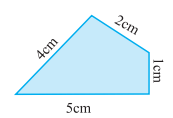
Answer: 12 cm Explanation: Perimeter = Sum of length of all sides of the given figure Perimeter = 4 cm + 2 cm + 1 cm + 5 cm Perimeter = 12 cm (b) 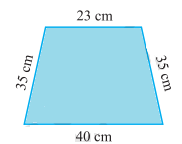
Answer: 133 cm Explanation: Perimeter = Sum of length of all sides of the given figure Perimeter = 35 cm + 23 cm + 35 cm + 40 cm Perimeter = 133 cm (c) 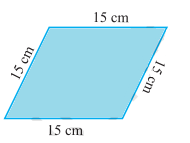
Answer: 60 cm Explanation: Perimeter = Sum of the length of all sides of the given figure Perimeter = 15 cm + 15 cm + 15 cm + 15 cm Perimeter =60 cm (d) 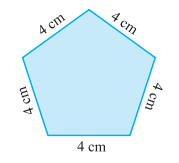
Answer: 20 cm Explanation: Perimeter = Sum of the length of all sides of the given figure Perimeter = 4 cm + 4 cm + 4 cm + 4 cm + 4 cm Perimeter = 40 cm (e) 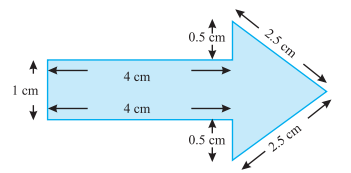
Answer: 15 cm Explanation: Perimeter = Sum of the length of all sides of the given figure Perimeter = 4 cm + 4 cm + 1 cm + 0.5 cm + 0.5 cm + 2.5 cm + 2.5 cm Perimeter = 15 cm (f) 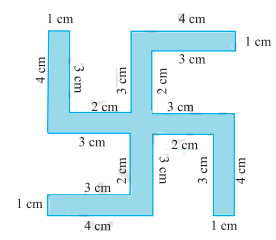
Answer: 52 cm Explanation: Perimeter = Sum of the length of all sides of the given figure Here, the four parts of the given have the same dimensions. So, we will find the sum of the first part and multiply it with 4. Perimeter = 4 � (4 cm + 3 cm + 3 cm + 2 cm + 1 cm) = 4 � 13 cm = 52 cm Or We can randomly calculate the total sum of the length of the sides of the given figure. Perimeter = 4 cm + 3 cm + 3 cm + 2 cm + 1 cm + 4 cm + 3 cm + 3 cm + 2 cm + 1 cm + 4 cm + 3 cm + 3 cm + 2 cm + 1 cm + 4 cm + 3 cm + 3 cm + 2 cm + 1 cm Perimeter = 52 cm 2. The lid of a rectangular box of sides 40 cm by 10 cm is sealed all round with tape. What is the length of the tape required? Answer: 100 cm or 1 m Explanation: Length of the tape = Sum of length of all sides of the rectangular box Sum of the length of all sides of a given figure is known as perimeter. Perimeter of a rectangle = 2 � (Length + Breadth) Perimeter = 2 � (40 + 10) = 2 � 50 = 100 cm Thus, the length of the tape required will be 100 cm. 1 m = 100 cm So, we can also say that the length of the tape required will be 1 m. 3. A table-top measures 2 m 25 cm by 1 m 50 cm. What is the perimeter of the table-top? Answer: 7.5 m or 7 m 50 cm Explanation: Perimeter of the table top = Sum of length of all sides of the rectangular table top Sum of the length of all sides of a given figure is known as perimeter. Perimeter of a rectangle = 2 � (Length + Breadth) 2 m 25 cm = 2.25 m (1 m = 100 cm) 1m 50 cm = 1.50 m Perimeter = 2 � (2.25 + 1.50) = 2 � 3.75 = 7.50 m Thus, the perimeter of the table top is 7.5 m or 7 m 50 cm. 4. What is the length of the wooden strip required to frame a photograph of length and breadth 32 cm and 21 cm respectively? Answer: 106 cm Explanation: Length = 32 cm Breadth = 21 cm Length of the wooden strip = Sum of length of all sides of the rectangular frame Sum of the length of all sides of a given figure is known as perimeter. Perimeter of a rectangle = 2 � (Length + Breadth) Perimeter = 2 � (32 + 21) = 2 � 53 = 106 cm Thus, the length of the wooden strip required framing a photograph of length and breadth 32 cm and 21 cm is 106 cm. 5. A rectangular piece of land measures 0.7 km by 0.5 km. Each side is to be fenced with 4 rows of wires. What is the length of the wire needed? Answer: 9.6 km Explanation: Length = 0.7 km Breadth = 0.5 km Length of the rectangular piece of land = Sum of length of all sides of the rectangular land Sum of the length of all sides of a given figure is known as perimeter. Perimeter of a rectangle = 2 � (Length + Breadth) Perimeter = 2 � (0.7 + 0.5) = 2 � 1.2 = 2.4 km The length required by the land to be fenced with 1 row of wire = 2.4 km The length required by the land to be fenced with 4 rows of wire = 2.4 km � 4 = 9.6 km 6. Find the perimeter of each of the following shapes: (a) A triangle of sides 3 cm, 4 cm and 5 cm. Answer: 12 cm Explanation: Sum of the length of all sides of a given figure is known as perimeter. Perimeter of a triangle = 3 cm + 4 cm + 5 cm = 12 cm (b) An equilateral triangle of side 9 cm. Answer: 27 cm Explanation: Sum of the length of all sides of a given figure is known as perimeter. Perimeter of an equilateral triangle = 3 � (Side) It is because all the sides of an equilateral triangle are equal. Perimeter of an equilateral triangle = 3 � 9 = 27 cm (c) An isosceles triangle with equal sides 8 cm each and third side 6 cm. Answer: 22 cm Explanation: Sum of the length of all sides of a given figure is known as perimeter. Perimeter of an isosceles triangle = 8 cm + 8 cm + 6 cm = 22 cm 7. Find the perimeter of a triangle with sides measuring 10 cm, 14 cm and 15 cm. Answer: 39 cm Explanation: Sum of the length of all sides of a given figure is known as perimeter. Perimeter of a triangle = 10 cm + 14 cm + 15 cm = 39 cm 8. Find the perimeter of a regular hexagon with each side measuring 8 m. Answer: 48 m Explanation: Sum of the length of all sides of a given figure is known as perimeter. A hexagon has six sides. Perimeter of the hexagon = 6 � (Side) It is because all the sides of a hexagon are equal. Perimeter of the hexagon = 6 � 8 = 48 m 9. Find the side of the square whose perimeter is 20 m. Answer: 5 m Explanation: Sum of the length of all sides of a given figure is known as perimeter. A square has four sides. Perimeter of the square = 4 � (Side) It is because all the sides of a square are equal. 20 m = 4 � (Side) Side = 20/4 Side = 5 m Thus, the side of the square of perimeter 20 is 5 m. 10. The perimeter of a regular pentagon is 100 cm. How long is its each side? Answer: 20 cm Explanation: Sum of the length of all sides of a given figure is known as perimeter. A pentagon has five sides. Perimeter of the pentagon = 5 � (Side) It is because all the sides of a pentagon are equal. 100 cm = 5 � (Side) Side = 100/5 Side = 20 cm Thus, the side of the pentagon of perimeter 100 is 20 cm. 11. A piece of string is 30 cm long. What will be the length of each side if the string is used to form? (a) A square? Answer: 7.5 cm Explanation: Sum of the length of all sides of a given figure is known as perimeter, which is equal to the length of the string. A square has four sides. Perimeter of the square = 4 � (Side) It is because all the sides of a square are equal. 30 cm = 4 � (Side) (Side) = 30/4 (Side) = 7.5 cm Thus, the length of each side of a square is 7.5 cm. (b) An equilateral triangle? Answer: 10 cm Explanation: Sum of the length of all sides of a given figure is known as perimeter, which is equal to the length of the string. An equilateral triangle has three sides. Perimeter of the equilateral triangle = 3 � (Side) It is because all the sides of the equilateral triangle are equal. 30 cm = 3 � (Side) (Side) = 30/3 (Side) = 10 cm Thus, the length of each side of an equilateral triangle is 10 cm. (c) A regular hexagon? Answer: 5 cm Explanation: Sum of the length of all sides of a given figure is known as perimeter, which is equal to the length of the string. A hexagon triangle has six sides. Perimeter of the hexagon = 6 � (Side) It is because all the sides of the hexagon are equal. 30 cm = 6 � (Side) (Side) = 30/6 (Side) = 5 cm Thus, the length of each side of the hexagon is 5 cm. 12. Two sides of a triangle are 12 cm and 14 cm. The perimeter of the triangle is 36 cm. What is its third side? Answer: 10 cm Explanation: Sum of the length of all sides of a given figure is known as perimeter. Perimeter of a triangle = Length of the first side + Length of the second side + Length of the third side 36 = 12 + 14 + Length of the third side 36 = 26 + Length of the third side Length of the third side = 36 - 26 = 10 cm Thus, the length of the third side of the triangle is 10 cm. 13. Find the cost of fencing a square park of side 250 m at the rate of rupees 20 per metre. Answer: Rupees 20000 Explanation: A square has four sides. Perimeter of the square = 4 � (Side) It is because all the sides of a square are equal. Perimeter = 4 � 250 = 1000 m Cost of fencing a square park = Perimeter � Cost per meter = 1000 � 20 = 20000 Thus, the cost of fencing a square park at the rate of rupees 20 per meter is 20000. 14. Find the cost of fencing a rectangular park of length 175 m and breadth 125 m at the rate of rupees 12 per metre. Answer: Rupees 7200 Explanation: Sum of the length of all sides of a given figure is known as perimeter. Perimeter of a rectangle = 2 � (Length + Breadth) Perimeter = 2 � (175 + 125) = 2 � 300 = 600 m Cost of fencing a rectangular park = Perimeter � Cost per meter = 600 � 12 = 7200 Thus, the cost of fencing a rectangular park at the rate of rupees 12 per meter is 7200. 15. Sweety runs around a square park of side 75 m. Bulbul runs around a rectangular park with length 60 m and breadth 45 m. Who covers less distance? Answer: Bulbul Explanation: Side of a square = 75 m Length of a rectangular park = 60 m Breadth of a rectangular park = 45m Perimeter of a square = 4 � (Side) Perimeter of a square = 4 � 75 = 300 m Perimeter of a rectangle = 2 � (Length + Breadth) Perimeter = 2 � (60 + 45) Perimeter = 2 � 105 = 210 m Perimeter of a rectangle < Perimeter of a square Thus, Bulbul covers less distance. 16. What is the perimeter of each of the following figures? What do you infer from the answers? (a) 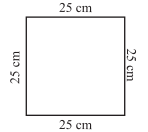
Answer: 100 cm Explanation: All the four sides of the above figure are equal, hence it is a square. Sum of the length of all sides of a given figure is known as perimeter. Perimeter of a square = 4 � (Side) Perimeter of a square = 4 � 25 = 100 cm (b) 
Answer: 100 cm Explanation: Sum of the length of all sides of a given figure is known as perimeter. Perimeter of a rectangle = 2 � (Length + Breadth) Perimeter = 2 � (40 + 10) Perimeter = 2 � 50 = 100 cm (c) 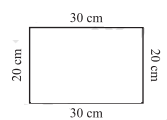
Answer: 100 cm Explanation: Sum of the length of all sides of a given figure is known as perimeter. Perimeter of a rectangle = 2 � (Length + Breadth) Perimeter = 2 � (20 + 30) Perimeter = 2 � 50 = 100 cm (d) 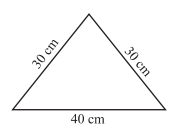
Answer: 100 cm Explanation: Sum of the length of all sides of a given figure is known as perimeter. Perimeter of a triangle = Sum of all the three sides Perimeter = 30 + 30 + 40 = 100 cm Here, we infer that all of the above figures have a perimeter of 100 cm. 17. Avneet buys 9 square paving slabs, each with a side of 1/2 m. He lays them in the form of a square. 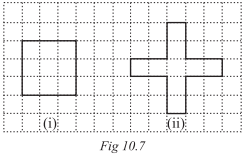
(a) What is the perimeter of his arrangement [Fig 10.7(i)]? Answer: 6 m Explanation: Side of each slab = 1/2m All the four sides of the above figure are equal, hence it is a square. Each sides has thee slabs. Length of each side = 1/2m +1/2m +1/2m = 3/2 m Perimeter of a square = 4 � (Side) Perimeter of a square = 4 � 3/2 = 6 m b) Shari does not like his arrangement. She gets him to lay them out like a cross. What is the perimeter of her arrangement [(Fig 10.7 (ii)]? Answer: 10 m Explanation: Sum of the length of all sides of a given figure is known as perimeter. There are total four crosses in the given figure. Each cross has five slabs. = � + � + � + � + � = 5/2 Perimeter of 1 cross = 5/2 m Perimeter of four crosses =4 � 5/2 m = 10 m Thus, the perimeter of the given cross figure is 10 m. (c) Which has greater perimeter? Answer: Cross Explanation: The perimeter of cross figure is 10 m, while the perimeter of square figure is 6 m. Hence, the perimeter of cross figure is greater. Exercise 10.21. Find the areas of the following figures by counting square: Area of 1 square = 1 sq units Area of half square = � sq units Area of more than half filled square = 1 sq units (approx.) Area of less than half filled square = 0 sq units (approx.) (a) 
Answer: 9 sq units Explanation: There are total nine numbers of squares in the given figure. Area = Number of square x Area of 1 square Area = 9 � 1 sq unit Area = 9 sq units (b) 
Answer: 5 sq units Explanation: There are total five numbers of squares in the given figure. Area = Number of square x Area of 1 square Area = 5 � 1 sq unit Area = 5 sq units (c) 
Answer: 4 sq units Explanation: Here, there are full as well as half squares present in the given figure. Number of full squares = 2 Area of full square = 2 � 1 sq unit = 2 sq units Number of half squares = 4 Area of half square = 4 � 1/2 sq unit = 2 sq units Total area = Area of full squares + area of half squares Total area = 2 sq units + 2 sq units Total area = 4 sq units (d) 
Answer: 8 sq units Explanation: There are total eight numbers of squares in the given figure. Area = Number of square x Area of 1 square Area = 8 � 1 sq unit Area = 8 sq units (e) 
Answer: 10 sq units Explanation: There are total ten numbers of squares in the given figure. Area = Number of squares x Area of 1 square Area = 10 � 1 sq unit Area = 10 sq units (f) 
Answer: 4 sq units Explanation: Here, there are full as well as half squares present in the given figure. Number of full squares = 2 Area of full square = 2 � 1 sq unit = 2 sq units Number of half squares = 4 Area of half square = 4 � 1/2 sq unit = 2 sq units Total area = Area of full squares + area of half squares Total area = 2 sq units + 2 sq units Total area = 4 sq units (g) 
Answer: 6 sq units Explanation: Here, there are full as well as half squares present in the given figure. Number of full squares = 4 Area of full square = 4 � 1 sq unit = 4 sq units Number of half squares = 4 Area of half square = 4 � 1/2 sq unit = 2 sq units Total area = Area of full squares + area of half squares Total area = 4 sq units + 2 sq units Total area = 6 sq units (h) 
Answer: 5 sq units Explanation: There are total five numbers of squares in the given figure. Area = Number of squares x Area of 1 square Area = 5 � 1 sq unit Area = 5 sq units (i) 
Answer: 9 sq units Explanation: There are total nine numbers of squares in the given figure. Area = Number of squares x Area of 1 square Area = 9 � 1 sq unit Area = 9 sq units (j) 
Answer: 4 sq units Explanation: Here, there are full as well as half squares present in the given figure. Number of full squares = 2 Area of full square = 2 � 1 sq unit = 2 sq units Number of half squares = 4 Area of half square = 4 � 1/2 sq unit = 2 sq units Total area = Area of full squares + area of half squares Total area = 2 sq units + 2 sq units Total area = 4 sq units (k) 
Answer: 5 sq units Explanation: Here, there are full as well as half squares present in the given figure. Number of full squares = 4 Area of full square = 4 � 1 sq unit = 4 sq units Number of half squares = 2 Area of half square = 2 � 1/2 sq unit = 1 sq unit Total area = Area of full squares + area of half squares Total area = 4 sq units + 1 sq units Total area =5 sq units (l) 
Answer: 8 sq units Explanation: Here, there are full, less than half filled squares, and more than half filled squares. Number of full squares = 2 Area of full square = 4 � 1 sq unit = 2 sq units Number of half-filled squares = 0 Number of more than half filled squares = 6 Area of 1 more than half filled square is considered as 1 sq unit. Area of more than half filled squares = 6 � 1 sq unit = 6 sq units Number of less than half filled squares = 6 Area of 1 less than half filled square is considered as 0 sq units. Area of more than half filled squares = 6 � 0 sq unit = 0 sq units Total area = Area of full squares + area of more than half filled squares + area of less than half filled squares Total area = 2 sq units + 6 sq units + 0 sq units Total area = 8 sq units (m) 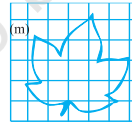
Answer: 14 sq units Explanation: Total number of squares in which the figure is drawn = 26 Here, there are full, less than half filled squares, and more than half filled squares. Number of full squares = 5 Area of full square = 5 � 1 sq unit = 5 sq units Number of half-filled squares = 0 Number of more than half filled squares = 9 Area of more than half filled squares = 9 � 1 sq unit = 9 sq units Number of less than half filled squares = 12 Area of 1 less than half filled square is considered as 0 sq units. Area of more than half filled squares = 12 � 0 sq unit = 0 sq units Total area = Area of full squares + area of more than half filled squares + area of less than half filled squares Total area = 5 sq units + 9 sq units + 0 sq units Total area = 14 sq units (n) 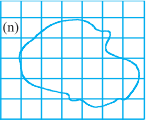
Answer: 18 sq units Explanation: Total number of squares in which the figure is present = 28 Here, there are full, less than half filled squares, and more than half filled squares. Number of full squares = 9 Area of full square = 9 � 1 sq unit = 9 sq units Number of half-filled squares = 0 Number of more than half filled squares = 9 Area of 1 more than half filled square is considered as 1 sq unit. Area of more than half filled squares = 9 � 1 sq unit = 9 sq units Number of less than half filled squares = 10 Area of 1 less than half filled square is considered as 0 sq units. Area of more than half filled squares = 10 � 0 sq unit = 0 sq units Total area = Area of full squares + area of more than half filled squares + area of less than half filled squares Total area = 9 sq units + 9 sq units + 0 sq units Total area = 18 sq units Exercise 10.31. Find the areas of the rectangles whose sides are: (a) 3 cm and 4 cm Answer: 12 sq cm Explanation: Area of rectangle = Length � Breadth Area of rectangle = 3 cm � 4 cm = 12 sq cm (b) 12 m and 21 m Answer: 252 sq m Explanation: Area of rectangle = Length � Breadth Area of rectangle = 12 m � 21 m Area of rectangle = 252 sq m (c) 2 km and 3 km Answer: 6 sq km Explanation: Area of rectangle = Length � Breadth Area of rectangle = 2 km � 3 km Area of rectangle = 6 sq km (d) 2 m and 70 cm Answer: 1.4 sq m Explanation: Area of rectangle = Length � Breadth Length = 2m Breadth = 70 cm Since the length and breadth are present in different units, we need to convert it into the same units. 1m = 100 cm Breadth = 0.7 m Area of rectangle = 2 m � 0.7 m = 1.4 sq m 2. Find the areas of the squares whose sides are: (a) 10 cm Answer: 100 sq cm Explanation: Area of square = Side � Side Area of square = 10 cm � 10 cm Area of square = 100 sq cm (b) 14 cm Answer: 196 sq cm Explanation: Area of square = Side � Side Area of square = 14 cm � 14 cm Area of square = 196 sq cm (c) 5 m Answer: 25 sq m Explanation: Area of square = Side � Side Area of square = 5 m � 5 m Area of square = 25 sq m 3. The length and breadth of three rectangles are as given below: (a) 9 m and 6 m Answer: 54 sq m Explanation: Area of rectangle = Length � Breadth Area of rectangle = 9 m � 6 m Area of rectangle = 54 sq m (b) 17 m and 3 m Answer: 51 sq m Explanation: Area of rectangle = Length � Breadth Area of rectangle = 17 m � 3 m Area of rectangle = 51 sq m (c) 4 m and 14 m Answer: 56 sq m Explanation: Area of rectangle = Length � Breadth Area of rectangle = 4 m � 14 m Area of rectangle = 56 sq m Which one has the largest area and which one has the smallest? Answer: The option (c) has the largest area (56 sq m) and option (b) has the smallest area (51 sq m). 4. The area of a rectangular garden 50 m long is 300 sq m. find the width of the garden? Answer: 6m Explanation: Area of the rectangular garden = 300 sq m Length of the rectangular garden = 50 m Area of rectangle = Length � Width 300 sq m = 50 m � Width Width = 300/50 Width = 6 m Thus, the width of the rectangular garden is 6m. 5. What is the cost of tiling a rectangular plot of land 500 m long and 200 m wide at the rate of rupees 8 per hundred sq m.? Answer: Rupees 8000 Explanation: Length of a rectangular plot = 500 m Width of a rectangular plot = 200 m Area = Length � Width Area = 500 � 200 Area = 100000 sq m Cost of tiling a rectangular plot = Area � Rate per square meter Cost of tiling a rectangular plot per square meter = 100000 sq m � 8 rupees = 800000 Cost of tiling a rectangular plot per hundred square meter = 800000/100 = Rupees 8,000 6. A table-top measures 2 m by 1 m 50 cm. What is its area in square metres? Answer: 3 sq m Explanation: Length of the table top = 2m Width of the table top = 1m 50 cm = 1.5 m Area of the table top = Length � Width Area of the table top = 2m � 1.5 m Area of the table top = 3 sq m 7. A room is 4 m long and 3 m 50 cm wide. How many square metres of carpet are needed to cover the floor of the room? Answer: 14 sq m Explanation: Length of the room = 4m Width of the room = 3m 50 cm = 3.5 m Area of the room = Length � Width Area of the room = 4m � 3.5 m Area of the room = 14 sq m Thus, 14 square metres of carpet are needed to cover the floor of the room. 8. A floor is 5 m long and 4 m wide. A square carpet of sides 3 m is laid on the floor. Find the area of the floor that is not carpeted. Answer: 11 sq m Explanation: Length of the floor = 5m Width of the floor = 4m Area of the floor = Length � Width Area of the floor = 5m � 4m Area of the floor = 20 sq m Side of the square carpet = 3m Area of square = Side � Side Area of square = 3 m � 3 m Area of square = 9 sq m Area of the floor not carpeted = Total area of the floor - carpeted area Area of the floor not carpeted = 20 - 9 = 11 sq m 9. Five square flower beds each of sides 1 m are dug on a piece of land 5 m long and 4 m wide. What is the area of the remaining part of the land? Answer: 15 sq m Explanation: Length of the land = 5m Width of the land = 4m Area of the land = Length � Width Area of the land = 5m � 4m Area of the land = 20 sq m Side of the square bed = 1m Area of square = Side � Side Area of square bed = 1 m � 1 m Area of square bed = 1 sq m Area of 5 square beds = 5 � 1 sq m = 5 sq m Area of the remaining part of the land = Total area - Area of 5 square beds = 20 - 5 = 15 sq m 10. By splitting the following figures into rectangles, find their areas (The measures are given in centimetres). (a) 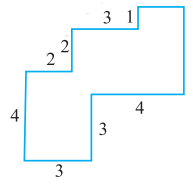
Answer: 28 sq cm Explanation: Let's split the above figure in four rectangles. 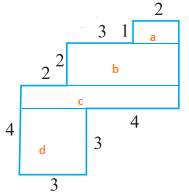
Total area = Area of rectangle a + Area of rectangle b + Area of rectangle c + Area of rectangle d 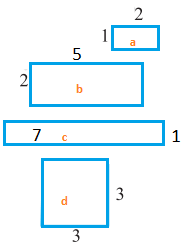
Total area = 1 � 2 + 2 � 5 + 1 � 7 + 3 � 3 Total area = 2 sq cm + 10 sq cm + 7 sq cm + 9 sq cm Total area = 28 sq cm (b) 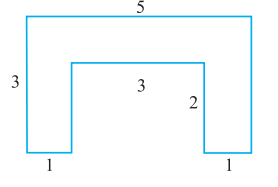
Answer: 9 sq cm Explanation: Let's split the above figure into three rectangles. 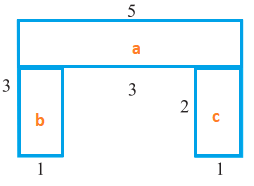
Total area = Area of rectangle a + Area of rectangle b + Area of rectangle c Total area = 5 � 1 + 2 � 1 + 1 � 2 Total area = 5 sq cm + 2 sq cm + 2 sq cm Total area = 9 sq cm 11. Split the following shapes into rectangles and find their areas. (The measures are given in centimetres.) (a) 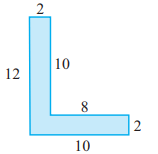
Answer: 40 sq cm Explanation: Let's split the above figure into two rectangles. 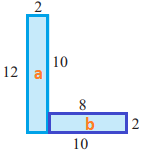
Total area = Area of rectangle a + Area of rectangle b Total area = 12 � 2 + 2 � 8 Total area = 24 sq cm + 16 sq cm Total area = 40 sq cm (b) 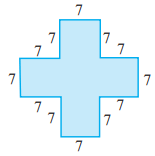
Answer: 245 sq cm Explanation: Let's split the above figure into three rectangles. 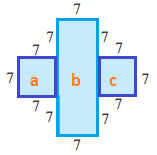
Length of rectangle b = (7 + 7 + 7) = 21 cm Total area = Area of rectangle a + Area of rectangle b + Area of rectangle c Total area = 7 � 7 + 21 � 7 + 7 � 7 Total area = 49 sq cm + 147 sq cm + 49 sq cm Total area = 245 sq cm (c) 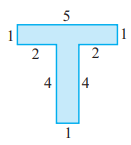
Answer: 9 sq cm Explanation: Let's split the above figure into two rectangles. 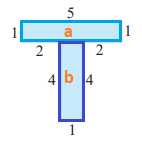
Total area = Area of rectangle a + Area of rectangle b Total area = 5 � 1 + 4 � 1 Total area = 5 sq cm + 4 sq cm Total area = 9 sq cm 12. How many tiles whose length and breadth are 12 cm and 5 cm respectively will be needed to fit in a rectangular region whose length and breadth are respectively? Area of tile = 12 cm � 5 cm Area of tile = 60 sq cm (a) 100 cm and 144 cm Answer: 240 tiles Explanation: Length of the rectangular region = 100 cm Width of the rectangular region = 144 cm Area of the rectangular region = Length � Width Area of the rectangular region = 100 � 144 = 14400 sq cm Area of tile = 60 sq cm Number of tiles needed to fit into the rectangular region = Area of rectangular region/Area of tile = 14400/60 = 240 Thus, 240 numbers of tiles are required to fit into the rectangular region. (b) 70 cm and 36 cm Answer: 42 tiles Explanation: Length of the rectangular region = 70 cm Width of the rectangular region = 36 cm Area of the rectangular region = Length � Width Area of the rectangular region = 70 � 36 = 2520 sq cm Area of tile = 60 sq cm Number of tiles needed to fit into the rectangular region = Area of rectangular region/Area of tile = 2520/60 = 42 Thus, 42 numbers of tiles are required to fit into the rectangular region.
Next TopicClass 6 Maths Chapter 11
|
 For Videos Join Our Youtube Channel: Join Now
For Videos Join Our Youtube Channel: Join Now
Feedback
- Send your Feedback to [email protected]
Help Others, Please Share









